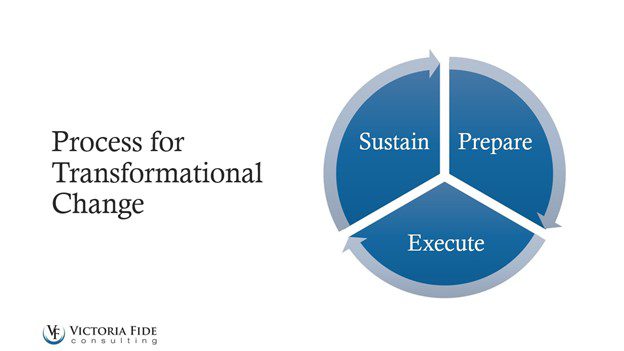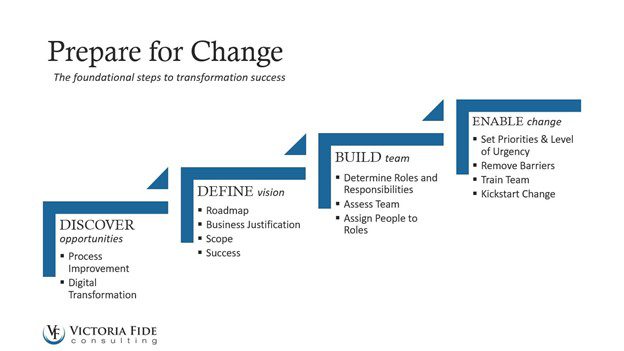
Preparing to Succeed with your Transformational Technology Initiatives
The first phase of the Victoria Fide Process for Transformational Change is Prepare (see graphic below). In my experience, preparedness is the number one determining factor for success with transformational technology initiatives. It is surprising how often significant projects are undertaken without proper preparation. What kind of preparation are we talking about? You may be thinking of things like create a budget, write a charter, or create a project plan. Actually, I’m referring to preparation that happens even before those activities and allows budgets and project plans to be more accurate.

We categorize the preparation activities into four categories; Discover, Define, Build, and Enable. The graphic below provides more information about these categories.

Discover
Most IT projects begin with a phase referred to as discovery so it is easy to be misdirected by this idea of preparation. I don’t mean requirements gathering or other aspects of a discovery phase of an IT project. What I mean by “discover” is to investigate and discover the true opportunities within the organization that are conducive to transformation. I also mean discovering the aspects of the organization that are resistant to transformation. You must know with a high level of certainty what must change, what can change and what obstacles must be removed to allow that change.
Define
Habit 2 of Stephen Covey’s “Seven Habits of Highly Effective People” is “begin with the end in mind”®.[1] It is imperative to define the end goal for all digital initiatives, both individually and collectively. The end goal needs to clearly articulate how the company will look and act once the planned initiatives are completed. This is not only success criteria, but a vision for a business reaping the benefits of successfully completing the initiatives.
Build
Knowing who to include in a transformational project is more difficult than people often realize. If you utilize your best people, your existing business could suffer or you could burn them out because they are still trying to do their “day job” and the project becomes their “night job.”
Some of the things to consider in choosing your team are:
- Business knowledge
- Industry knowledge
- System knowledge
- Personality
- Capability
- Desire
Sometimes, people who know the business best only know what has always been done but may have no knowledge of industry best practices or no vision for process improvement. If they know the existing system very well, they may be reluctant to implement a new system unless it looks and feels exactly like the existing system which leaves no room for improvement. Other times, people could really add value to the discussion of automating or improving existing processes, but they simply are not good collaborators and can really damage team morale. In many cases, your best people simply do not have the skills to translate their knowledge into useful requirements or they simply do not want anything to change.
Some of these issues can be addressed with training and coaching and some can be addressed with skillful business analysts. It is important to do a thorough assessment of project team candidates and choose the right team. Remember, if you do not have the right team members you may be able to augment your team with skilled contract workers.
Enable
If you have the right vision and the right team the final step of preparation is to set expectations and remove barriers. There may be a need to remove some of the day-to-day business responsibilities from your project team so they can focus on the project. You may need to backfill with augmentation to help with either their normal business responsibilities or to help with project responsibilities. You may need to provide some project related training such as how to be a subject matter expert or a business process owner. You definitely need to clearly define the project governance expectations. These should be handled prior to the full project kickoff so the proper expectations can be communicated during the kickoff.
Conclusion
Of course, in a short article like this, I cannot adequately discuss all that is necessary to succeed with transformational technology initiatives. However, I hope this article has given you something to think about. If you are thinking about starting a transformational technology initiative and would like to know more about our process or would like to discuss how we may help you, you can reach out to us at info@victoriafide.com
[1] Covey, Steven. “THE 7 HABITS OF HIGHLY EFFECTIVE PEOPLE”
